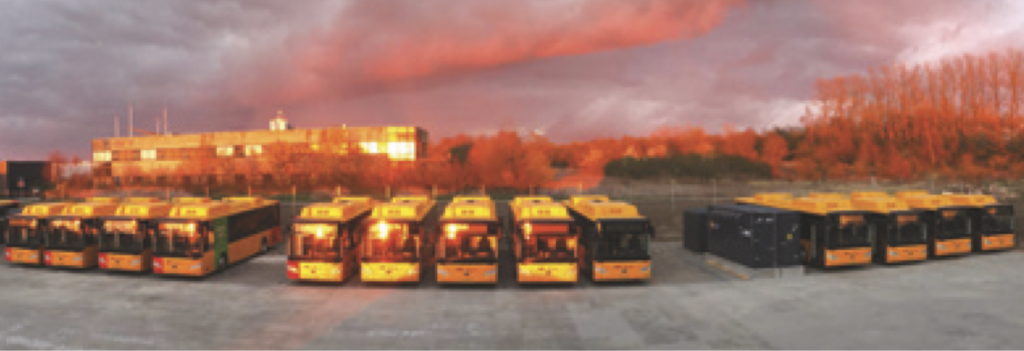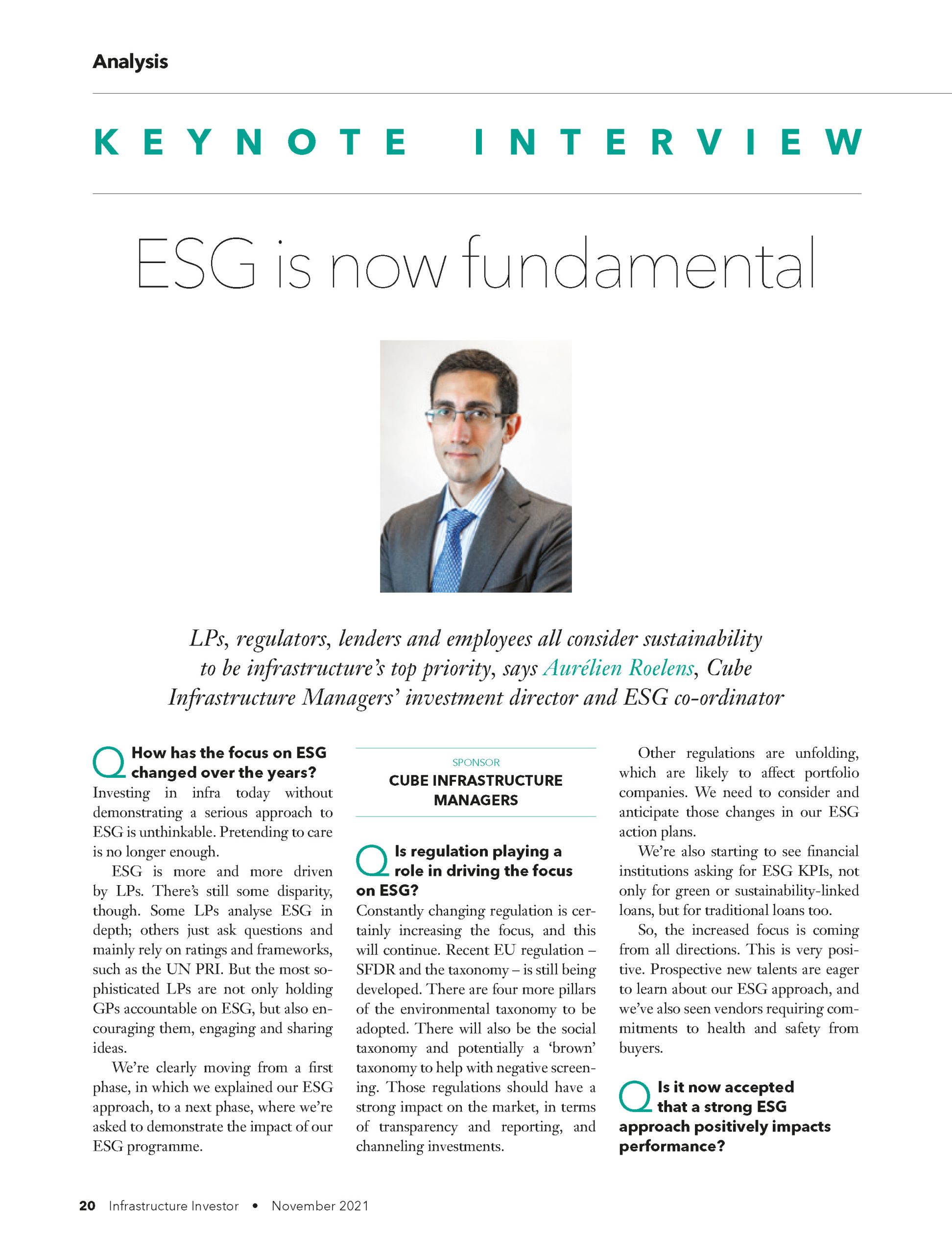LPs, regulators, lenders and employees all consider sustainability to be infrastructure’s top priority, says Aurélien Roelens, Cube Infrastructure Managers’ investment director and ESG co-ordinator
How has the focus on ESG changed over the years?
Investing in infra today without demonstrating a serious approach to ESG is unthinkable. Pretending to care is no longer enough.
ESG is more and more driven by LPs. There’s still some disparity, though. Some LPs analyse ESG in depth; others just ask questions and mainly rely on ratings and frameworks, such as the UN PRI. But the most sophisticated LPs are not only holding GPs accountable on ESG, but also encouraging them, engaging and sharing ideas.
We’re clearly moving from a first phase, in which we explained our ESG approach, to a next phase, where we’re asked to demonstrate the impact of our ESG programme.
Is regulation playing a role in driving the focus on ESG?
Constantly changing regulation is certainly increasing the focus, and this will continue. Recent EU regulation – SFDR and the taxonomy – is still being developed. There are four more pillars of the environmental taxonomy to be adopted. There will also be the social taxonomy and potentially a ‘brown’ taxonomy to help with negative screening. Those regulations should have a strong impact on the market, in terms of transparency and reporting, and channeling investments.
Other regulations are unfolding, which are likely to affect portfolio companies. We need to consider and anticipate those changes in our ESG action plans.
We’re also starting to see financial institutions asking for ESG KPIs, not only for green or sustainability-linked loans, but for traditional loans too.
So, the increased focus is coming from all directions. This is very positive. Prospective new talents are eager to learn about our ESG approach, and we’ve also seen vendors requiring commitments to health and safety from buyers.
Is it now accepted that a strong ESG approach positively impacts performance?
Our core strategy is to buy, control and grow operating companies over the long term. That means a strong and pragmatic ESG approach – anticipating the needs of communities as well as taking into consideration environmental trends – is a prerequisite to value creation. This value creation was primarily framed based on risk reduction a few years ago, but the market is now acknowledging other dimensions, including cost reduction and opportunity creation.
It’s not as easy to measure these impacts. Within public transport, an EV programme and subsequent fuel consumption reduction IRR can be measured, as can the IRR of installing PV to provide electricity to a fibre-access point. The lower spread on a green financing is another obvious metric that positively impacts performance. However, such factors still fail to capture the additional increased resilience of the underlying asset, risk reduction and opportunity creation, which are all more difficult to evaluate and quantify.
The best proof is the value obtained at exit, even though commingled with other factors.
How has Cube fine-tuned its ESG approach to reflect these changes?
In 2016, we adopted our Environ- mental, Social, Management System – Responsible Investment policy. That ESMS-RI ensures that the results of the ESG due diligence carried out by third parties and complementary analysis conducted internally are systematically presented and discussed during the investment committees. Additionally, post-acquisition, a comprehensive ESG action plan is immediately set up with clear deadlines and KPIs. These action plans must be approved by the ESG co-ordinator and the board of each portfolio company.
Subsequently, we’ve created an ESG co-ordination team composed of investment team members, to better monitor, assist management and foster best-practice sharing. What’s important is that the team in charge of the investment and the asset management is also responsible and accountable for the ESG programme, including encouraging new initiatives and monitoring action plans. We’ve also set up an ESG committee meeting several times a year to further strengthen our commitment.
We continue to push the integration of ESG and climate considerations further in our investment and risk management processes, including through the introduction of additional and enhanced metrics. We also consider ESG factors when making new hires and have found that it’s important to bring scientific skillsets on board, rather than just having pure financial backgrounds.

THE ELECTRIC BUS REVOLUTION
Greening transport is a major priority within the energy transition and decarbonisation, and a significant focus is naturally falling on the public transport sector
According to Stefan Weis, managing director of Cube’s public transport platform, “it’s much easier and more efficient to shift a public transport fleet to non-combustion engines than it is to green every individual car”.
This is creating investment opportunities across the ferry and train sectors, but Weis believes it is the electric bus sector that is most exciting. In Denmark, for example, where Cube is invested in the bus company Umove, two-thirds of new commuter transport buses are set to be electric.
“Electric bus fleets require higher capex than traditional diesel vehicles, but then energy and maintenance costs are lower,” Weis explains. “At the same time, electric bus prices are declining and ranges are increasing, which means electric buses are on the way to becoming cost-competitive across the life cycle.”
Growing demand for electrification is creating growth opportunities. “There are also opportunities to promote consolidation in the sector, because smaller players don’t have the capital or expertise to establish these new fleets and the related charging infrastructure,” says Weis.
Umove has now won tenders representing almost 100 electric buses and has become the number two public transport bus company in Denmark.
How has investing behind the ‘E’ enhanced asset performance?
The environment has been the primary focus because it’s an area where the asset class can have a significant impact. And there are two good examples from our first fund, where investing behind environmental themes, such as district heating, and focusing on enhancing the environmental credentials of our assets resulted in highly successful exits.
The first is Idex, a major French district heating player, which we owned from 2011 to 2018. While most of the traditional district heating networks were fossil-fuel based, we encouraged the management team to differentiate themselves by creating a toolbox of alternative and greener solutions including biomass, waste, geo-thermal and concentrated solar power.
We also focused on maximising the use of local resources – for example, using the River Seine for cooling or a data centre for heating. This positioned the company ahead of the curve on several tenders with greener and often cheaper solutions, resulting in growth.
Another example is Boreal, a Norwegian company, where we launched an electric bus project in 2012. We refined this project until we were ready to launch it on real lines in 2015, giving the company a competitive advantage for the first tenders incorporating electric buses in 2017.
These are positive experiences that we continue to leverage on and further develop across our current investments in district heating, public transport and in telecoms.
Is there a greater focus on the ‘S’ and ‘G’ too?
The social and governance dimensions have always been critical for us. We ensure the companies we back have fully adopted and integrated the appropriate policies and processes, including a code of ethics and whistleblower policies. We closely monitor social KPIs and implement different initiatives to improve diversity, reduce absences and encourage training programmes, among other things.
Moreover, the pandemic’s put a greater spotlight on social and governance issues, and has raised a lot of questions. How do you ensure the integrity of processes and controls in a remote working environment? How do you continue delivering essential services while protecting employees and the population they may be in contact with? How do you maintain corporate culture and the motivation and mental health of employees working from home? We had to deploy strong measures to address these questions in each of our portfolio companies.
The pandemic also raised questions regarding our responsibility to wider society. Digital infra, for example, became more important than ever to avoid isolation. To address this systemic issue brought on by the pandemic, we took the step of offering free bandwidth upgrades during lockdowns, introducing social tariffs with our fiber business G.Network in London, and facilitating connectivity in hospitals and care homes with dst telecom in Portugal.
How has investing behind the ‘S’ enhanced asset performance?
Digital inequality is a clear risk for rural territories with a potential new exodus of businesses and residents. Our strong belief when investing in Covage in France, back in 2011, was that rural open-access fibre networks were a pertinent answer and a sound investment opportunity. And this has been well proven during the exit. We’ve since made several similar investments across Europe with both Cube Infrastructure Fund II and the Connecting Europe Broadband Fund.
Working on the ‘S’ is also key to creating value. For instance, in some sectors, there’s a shortage of human resources, including bus drivers and fibre installation experts. Several of our portfolio companies, particularly in the telecom and public transport industries, have developed hiring and training programmes targeting refugees, immigrants and local underprivileged youth. Such initiatives have enabled our portfolio companies to address the resource shortage with motivated talents, while also creating positive corporate cultures and goodwill with local communities and authorities.
How do you expect ESG to evolve?
Addressing climate change is going to be critical, as it impacts other major themes such as biodiversity and social inequality. The full impact of today’s emissions will only be felt in 10 to 20 years, and we don’t know when the international effort will allow us to reach carbon neutrality.
In the five scenarios of the Intergovernmental Panel on Climate Change, two are at or above a 4 degrees Celsius increase. We’re not in a linear system – effects can accumulate, a natural carbon sink can become less potent, and there are other unknowns, such as the recent news about the Gulf Stream weakening.
It’s vital that investors participate in the transition while adapting their infrastructure to potential consequences and making it more resilient. The evaluation of infrastructure resilience against an increased frequency and intensity of extreme events will become more systematic in investment decisions and in adaptation plans during the holding period.
With climate change mitigation, there will be opportunities to deploy more capital to reduce GHG emissions, by greening vehicle fleets and repurposing plants with more renewable energy sources. There will also be opportunities to invest in sectors that are not yet mainstream. For example, we recently made our first investments in EV charging and in low-energy IoT infrastructure. We’re also looking at opportunities such as green hydrogen distribution and production.
There are obviously many more investment opportunities, including energy storage, carbon capture, decarbonisation infrastructure and green ammonia production. But not all of these pathways can be achieved through our buy-and-grow brownfield platforms. This creates an opportunity for specialised greenfield funds targeting both impact and financial returns. This is something we’re closely following.
